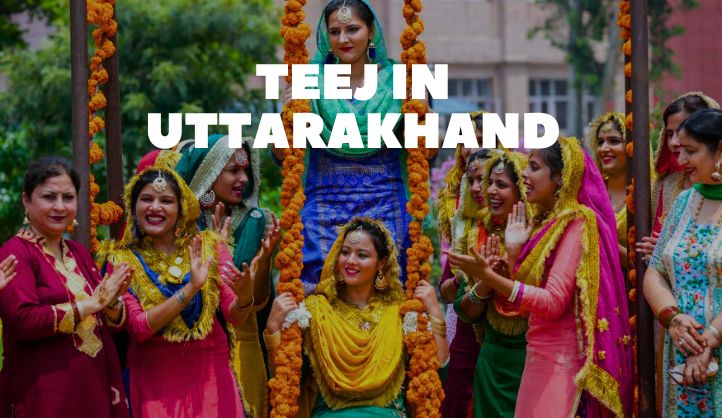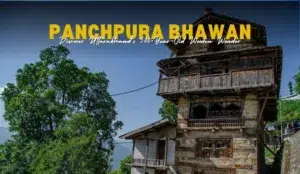Uttarakhand comes alive with vibrant colors and joyous festivities during the monsoon season. One such celebration that holds immense cultural significance for women is Teej. Celebrated on the third day after the new moon in the Shraavana month (typically falling in July or August), Teej is a festival dedicated to Goddess Parvati and her union with Lord Shiva.
A Festival Steeped in Tradition
Teej, also known as Hariyali Teej or Sindhara Teej, is observed with immense enthusiasm by women across Uttarakhand. The verdant monsoon season sets the perfect backdrop for this festival, symbolizing fertility, marital bliss, and the unwavering bond between a wife and husband.
Preparations and Significance
Weeks leading up to this festival witnessed a flurry of activity in households. Women adorn their homes with vibrant rangolis (colorful floor art) and mango leaves, invoking the blessings of prosperity. The spirit of togetherness is palpable as women visit friends and relatives, exchanging gifts of mehndi cones, bangles, and sweets.
The Day of Festivities
On the day of this festival, women wake up before dawn and observe a strict fast. They don their most beautiful attire, traditionally a vibrant green or red saree or lehenga, adorned with intricate gold jewelry. Mehndi (henna) designs are etched on hands and feet, adding an artistic touch to their attire.
The Heart of the Festival – Puja and Singing
The core of Teej revolves around the puja (worship) of Goddess Parvati and Lord Shiva. Women gather in temples or at home, offering prayers and seeking blessings for a happy married life and the well-being of their families. Melodious devotional songs called “Teej Geet” resonate throughout the day, echoing tales of love, longing, and the unwavering devotion of Parvati towards Shiva. These soulful songs often passed down through generations, narrate the story of Parvati’s quest to win Shiva’s heart.
A Time for Merriment and Celebration
Following the puja, the festive spirit takes center stage. Women come together in open spaces or courtyards, forming circles to sing and dance in joyous abandon. The rhythmic beats of the dhol (drum) provide a lively backdrop as women perform the “Teej ki Nauli” – a graceful dance characterized by synchronized steps and spins. The atmosphere is electric, filled with laughter, camaraderie, and the vibrant spirit of the festival.
The Significance of Swings
A unique and delightful element of this festival in Uttarakhand is the tradition of swinging. Elaborately decorated swings, known as “jhoolas,” are set up on trees or makeshift frames. Women take turns swaying on these swings, singing playful songs and sharing stories. This playful custom is believed to bring good luck and blessings for a happy married life.
Variations Across the State
While the essence of Teej remains the same across Uttarakhand, there might be slight variations in rituals and traditions practiced in different regions. For instance, in Kumaon, women offer “haldi chawal” (rice and turmeric) to Goddess Parvati, while in Garhwal, sweets made from milk and lentils are offered.
A Celebration Beyond Religion
Teej transcends religious boundaries. Even unmarried girls and women of other faiths participate in the festivities, enjoying the vibrant cultural experience and celebrating the monsoon season. The festival fosters a sense of community and strengthens social bonds among women.
Teej and the Environment
The festival holds an underlying environmental significance. The monsoon season brings renewed life to the region, and Teej is a gentle reminder to respect and nurture nature. The use of natural elements like mango leaves and swings made from local materials reflects a harmonious connection with the environment.
A Feast for the Senses – Teej Delicacies
No celebration is complete without a delectable spread. Teej boasts a unique array of dishes prepared specifically for the occasion. “Gehu ka halwa” (a sweet dish made from wheat flour), “pakoras” (savory fritters), and “malpua” (pancakes dipped in sugar syrup) are some of the popular treats enjoyed during the festival.
Teej in Modern Times
While Teej remains deeply rooted in tradition, it has adapted to the changing times. Many cultural organizations and community centers host grand Teej celebrations, featuring dance competitions, singing performances, and fashion shows. Social media has also played a role in showcasing the vibrancy of Teej, with women sharing photos and videos of their celebrations online.
Some Other Festivals of Uttarakhand
Uttarakhand, the land of towering Himalayas and sacred rivers, is a treasure trove of vibrant festivals celebrated throughout the year. Here’s a glimpse into some other prominent festivals that add to the cultural tapestry of this beautiful state:
Kumbh Mela
Arguably the grandest Hindu pilgrimage and festival in the world, the Kumbh Mela is a sight to behold. Held once every 3 years, alternating between Haridwar and Rishikesh, the Kumbh Mela witnesses millions of devotees converging on the banks of the Ganges to take a holy dip, believed to wash away sins and grant spiritual liberation.
Nanda Devi Raj Jaat
This captivating procession, held every 3 years in the months of June-July, is a tribute to the revered Nanda Devi, the embodiment of the Himalayas. The procession starts from Naula village in Gopeshwar and culminates at Nanda Devi’s shrine in Dokiani. Villagers dressed in vibrant attire carry a beautifully decorated palanquin (portable shrine) of the Goddess, accompanied by rhythmic beats of drums and soulful hymns.
Basant Panchami
Marking the arrival of spring, Basant Panchami is a festival dedicated to Saraswati, the Hindu Goddess of knowledge, music, and arts. Celebrated in January or February, the state comes alive with vibrant hues of yellow. People wear yellow clothes, offer yellow flowers and sweets to the Goddess, and participate in cultural events like Saraswati puja and Saraswati Vandana (prayer).
Uttarayani
Marking the end of the six-month inauspicious period according to the Hindu calendar, Uttarayani falls in January. Celebrated with immense enthusiasm, especially in Kumaon, Uttarayani is a time for kite flying. The skies come alive with a kaleidoscope of colorful kites, symbolizing soaring hopes and aspirations. People also indulge in delicious delicacies like “makki ki roti” (corn flour flatbread) and “sarson ka saag” (mustard greens curry).
Conclusion
Teej is more than just a festival, it’s a vibrant tapestry woven with faith, cultural pride, and the enduring spirit of womanhood. It’s a time for women to come together, celebrate their strength and resilience, and reaffirm the importance of family and community. The echoes of Teej Geet and the joyous dances under the monsoon sky leave a lasting impression, reminding us of the beauty and joy embedded in traditions.
FAQs about Teej in Uttarakhand
1. When is Teej celebrated in Uttarakhand?
Teej is celebrated on the third day after the new moon in the Shraavana month, which typically falls in July or August.
2. What is the significance of the color green during Teej?
Green symbolizes the lush monsoon season, fertility, and new beginnings. It’s a popular color for clothing and decorations during the festival.
3. What is Teej Geet?
Teej Geet are traditional devotional songs sung by women during the festival. These songs narrate stories of love, longing, and the devotion of Parvati towards Shiva.
4. What is the significance of swings (jhoolas) in Teej?
Swinging on jhoolas is believed to bring good luck and blessings for a happy married life. It’s a playful tradition that adds to the joyous spirit of Teej.
5. Can unmarried women participate in Teej celebrations?
Absolutely! Teej is open to all women, regardless of marital status. Unmarried girls can participate in the festivities, enjoying the cultural experience and celebrating the monsoon season.





